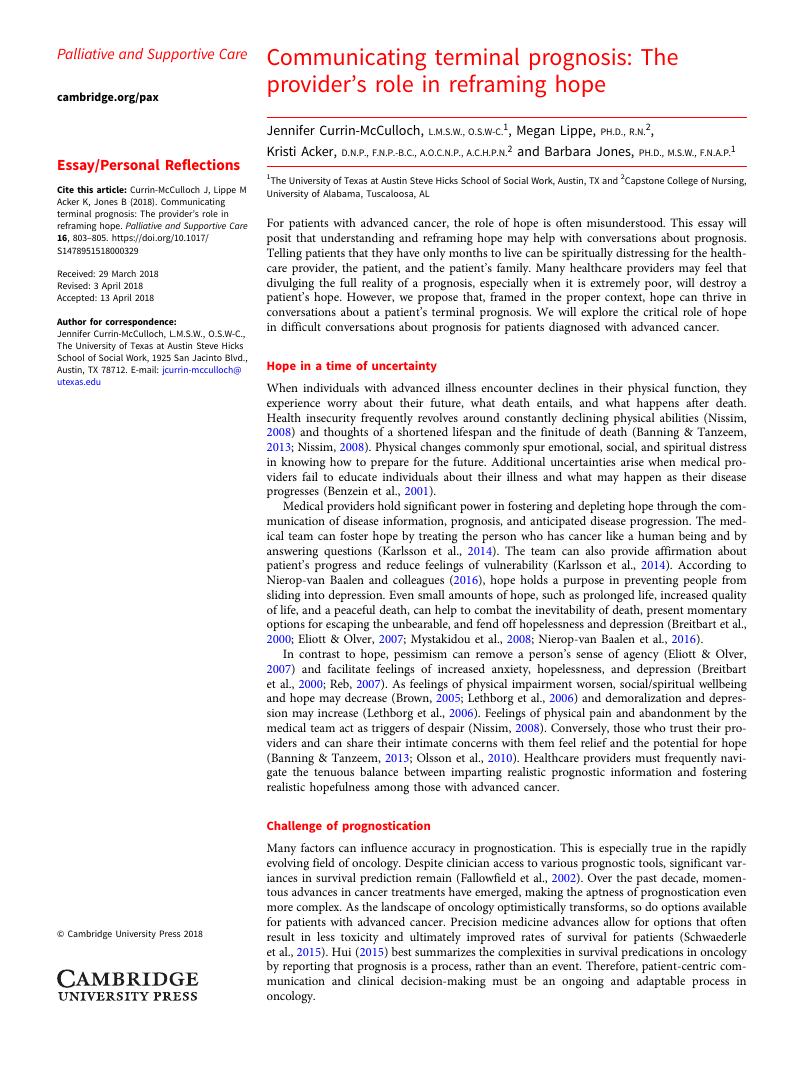Crossref Citations
This article has been cited by the following publications. This list is generated based on data provided by Crossref.
Lippe, Megan
Farya, Phillips
Jennifer, McCulloch
Stanley, Alexandra
Barbara, Jones
and
Boone, Goodgame
2020.
Communicating Oncologic Prognosis With Empathy: A Pilot Study of a Novel Communication Guide.
American Journal of Hospice and Palliative Medicine®,
Vol. 37,
Issue. 12,
p.
1029.
Grignoli, Nicola
Wullschleger, Roberta
Di Bernardo, Valentina
Amati, Mirjam
Zanini, Claudia
Malacrida, Roberto
and
Rubinelli, Sara
2021.
Hope and therapeutic privilege: time for shared prognosis communication.
Journal of Medical Ethics,
Vol. 47,
Issue. 12,
p.
e47.
Tavares, Alze Pereira dos Santos
Santos, Cássia Gomes da Silveira
Tzanno-Martins, Carmen
Barros Neto, José
Silva, Ana Maria Misael da
Lotaif, Leda
and
Souza, Jonathan Vinicius Lourenço
2021.
Kidney supportive care: an update of the current state of the art of palliative care in CKD patients.
Brazilian Journal of Nephrology,
Vol. 43,
Issue. 1,
p.
74.
Zhang, Anao
Ji, Qingying
Zhang, Kan
Cao, Qing
Chen, Yuting
Chen, Jingzhi
and
DuVall, Adam
2022.
Solution-focused brief therapy for adolescent and young adult cancer patients in China: a pilot randomized controlled trial.
Journal of Psychosocial Oncology,
Vol. 40,
Issue. 6,
p.
816.
Stevenson-Baker, Sara
2023.
Promoting person-centred care at the end of life.
Nursing Standard,
Vol. 38,
Issue. 11,
p.
76.
Harnischfeger, Nele
Rath, Hilke M.
Alt‐Epping, Bernd
Brand, Hannah
Haller, Karl
Letsch, Anne
Rieder, Nicola
Thuss‐Patience, Peter
Bokemeyer, Carsten
Oechsle, Karin
and
Bergelt, Corinna
2023.
Association between oncologists' death anxiety and their end‐of‐life communication with advanced cancer patients.
Psycho-Oncology,
Vol. 32,
Issue. 6,
p.
923.
Heikkinen, Peter J.
and
Roberts, Benjamin
2023.
I see you: a Chaplain case study on existential distress and transdisciplinary support.
Journal of Health Care Chaplaincy,
Vol. 29,
Issue. 4,
p.
406.
Lillie, Helen M.
2024.
Healthcare Providers’ Resilience Communication: A New Type of Patient-Centered Communication.
Journal of Health Communication,
Vol. 29,
Issue. 8,
p.
514.


